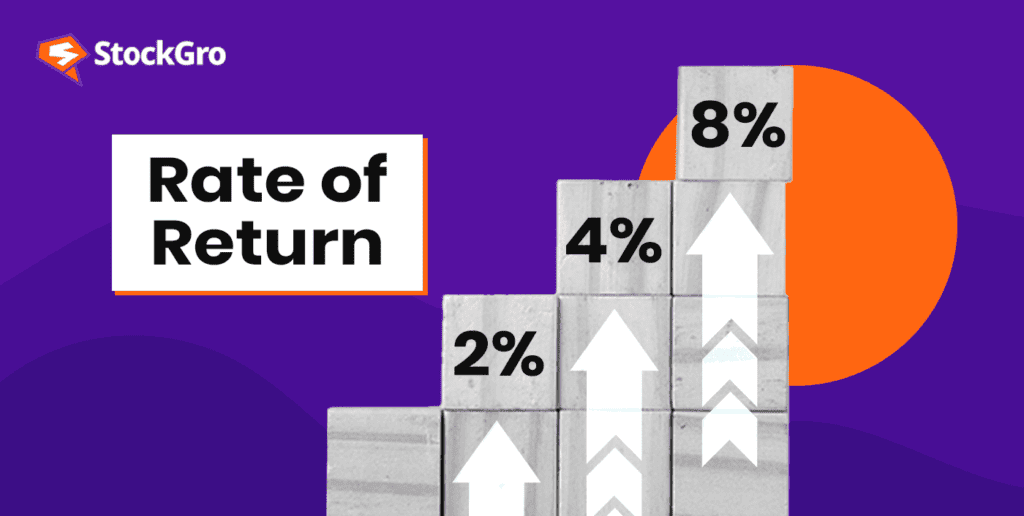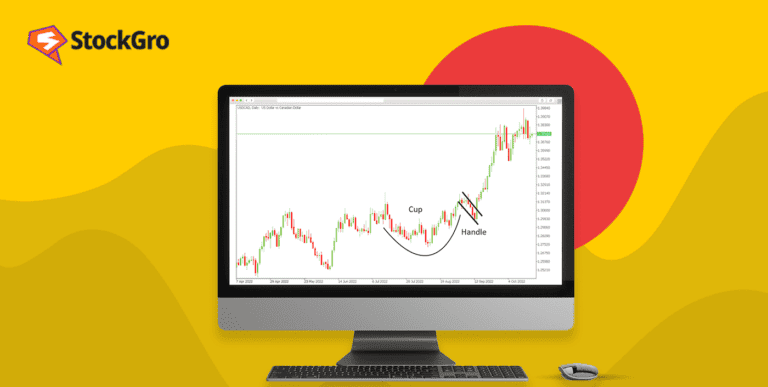
Investments refer to spending money on assets that will increase your money’s worth. But how do you assess if your investments are in the right direction? The most basic way of analysing the power of investments is to assess their yield. An investment is good if the return is higher than the cost spent on acquiring it.
In this article, let us talk about the assessment of investments through the concept of RoR. While RoR has different abbreviations in different contexts, the full form of RoR in finance is Rate of Return.
You may also like: Discounted cash flow – Concept and computation
What is the rate of return?
The rate of return is an indicator that suggests the profit or loss earned from an investment. It is ascertained as a percentage of the cost spent on making an investment. A positive rate of return suggests a profitable investment, while a negative return indicates an investment with a loss.
Why is the rate of return essential?
The rate of return is a crucial aspect of investing as it suggests whether the investment are useful or futile. It also helps in planning future investments accordingly.
Rate of return is also called the return on investment and applies to all kinds of investments. Whether we talk about purchasing financial assets like stocks and bonds, real estate assets like sites and houses, or other physical assets like machinery, the concept of calculating returns is relevant.
Analysing the rate of return helps investors make further decisions regarding the disposal of non-productive assets and increasing investments in productive assets.
Understanding the RoR is essential for several reasons:
- Profitability: A higher rate of return indicates a more profitable investment.
- Risk Assessment: Helps in understanding the risk-return trade-off.
- Future Planning: Assists in making strategic investment decisions.
Let’s break down these points to understand better.
Firstly, it provides a sense of profitability of an investment. For instance, anybody who has invested in a stock will worry whether they have made an investor’s return out of it — if you get 10% from the stock, can another 10% be got more easily elsewhere? Secondly, RoR is useful in evaluating the risk of an investment. While higher returns usually bring with them higher risks, knowing this intricate balance is important in making informed choices.
Moreover, the rate of return is important for long-term financial planning. For example, if an investor aims to save for retirement, knowing the expected rate of return on their investments can help them calculate how much they need to invest regularly to achieve their financial goals.
According to a study by Vanguard, the average annual return for a balanced portfolio of 60% stocks and 40% bonds over the past 90 years has been around 8.7%. This historical data can guide investors in setting realistic expectations for their investments.
In addition, the rate of return can influence the allocation of assets in a portfolio. Investors may choose to allocate more funds to high-return investments while maintaining a balance with safer, lower-return assets to manage risk. This strategic allocation is essential for optimizing returns while minimizing potential losses.
Rate of return formula and how to calculate rate of return on investment?
Rate of return formula = (Today’s market value of the investment – Initial amount invested) / Initial amount * 100
While this is the basic formula, the method of calculation may vary for some assets based on their features.
Consider physical assets like machinery, whose value will depreciate with time. Using the above formula in such cases will definitely show a negative rate of return, which may be misleading. In such situations, investors must calculate the return on investment based on the number of units produced by the machinery and the cash flow related to selling those units.
The prices of financial assets like stocks and bonds fluctuate based on market conditions. Apart from that, investors also benefit from cashflows like dividends and interest for stocks and bonds, respectively. Hence, investors should consider the difference in value as well as cashflows while calculating return on investments on such assets.
Example of rate of return
A person invests in ₹25,00,000 in a real estate property. Five years later, the asset is worth ₹32,00,000.
So, the rate of return on this investment is:
= (32,00,000 – 25,00,000)/25,00,000 * 100
= 28%
Let us consider an example of investment in shares.
Trader A invests ₹10,000 to buy 100 shares of Company ABC at ₹100 each.
The market price of the share after five years is ₹600 per share, and trader A has earned a dividend of ₹1000 in 5 years.
His rate of return is:
= ([600*100] – 10000) + 1000) / 10000 * 100 = (51,000/10,000) * 100
= 510%
Also Read: What is CAGR and how to calculate? [ Explained]
Variations in calculating the rate of returns
There are various concepts that help investors analyse how their investments are performing. Here are some ways which use the basic idea of rate of return with some variations to analyse returns from different aspects:
- Average rate of return method (ARR)
Also called the annual average rate of return or accounting rate of return, this considers the average returns of an investment over its total life, against the initial cost of investments. This approach is particularly useful for investors who want to understand the overall profitability of their investments over a specific period.
So, if an investor makes an investment for a period of 5 years, the return for each year is calculated and averaged out to determine the overall return on investment. This method provides a straightforward way to assess the performance of an investment without getting bogged down by the complexities of compounding or varying annual returns.
Accounting rate of return formula = Average profit or loss per year / Initial cost * 100
This formula helps investors to quickly calculate the efficiency of their investments. For example, if an investment of ₹1,00,000 yields an average annual profit of ₹20,000, the ARR would be:
ARR = (20,000 / 1,00,000) * 100 = 20%
This means the investment generates a 20% return on the initial cost each year, on average. The ARR method is particularly appealing for its simplicity and ease of use, making it a popular choice among investors who prefer a clear and concise measure of investment performance.
- Real rate of return
The basic rate of return generally considers the direct investment cost to returns. However, there are other costs related to investments. To ascertain the actual rate of return, it is essential that all the related costs are considered. Hence, the real rate of return shows the return on investments after deducting all related costs like tax, inflation rate, brokerage fees, etc.
The real rate of return is a more accurate measure of an investment’s profitability because it accounts for the erosion of purchasing power due to inflation.
For example, if you earn a 10% return on an investment but inflation is 3%, your real rate of return is only 7%. Additionally, taxes and fees can significantly impact your returns. By considering these factors, investors can make more informed decisions and better understand the true value of their investments.
Real rate of return = Rate of return – Other costs – Inflation rate
Understanding the real RoR is crucial for long-term financial planning and achieving your investment goals. It helps you to compare different investment opportunities on a like-for-like basis and ensures that your investments are genuinely growing in value over time.
- Compound Annual Growth Rate (CAGR)
When evaluating the performance of investments, especially mutual funds, it’s crucial to consider how returns are reinvested. Year-on-Year returns are often reinvested back with the initial investment, which means the absolute RoR doesn’t capture the full picture. This is where the Compound Annual Growth Rate (CAGR) comes into play.
CAGR provides a more accurate measure of an investment’s annual growth rate over a specified period, considering the effect of compounding. It smooths out the volatility of periodic returns and gives a single annual growth rate that represents the investment’s performance over time. The formula for CAGR is:
CAGR = [(Current Value / Initial Cost) ^ (1 / n)] – 1
where N is the investment tenure in years.
For example, if you invested ₹10,000 in a mutual fund five years ago, and its current value is ₹20,000, the CAGR would be:
CAGR = [(20000 / 10000) ^ (1 / 5)] – 1 = 0.1487 or 14.87%
This means your investment grew at an average annual rate of 14.87% over the five years. By using CAGR, investors can make more informed decisions and compare the performance of different investments on a like-for-like basis. It’s a powerful tool for understanding the true growth potential of your investments and planning for future financial goals.
- Discounted Cash Flow (DCF)
The DCF method considers the time value of money, which is a crucial aspect when evaluating investments. It uses projected cash flows to ascertain the present value of an investment, helping investors make informed decisions. The DCF method is particularly useful for long-term investments, as it accounts for the varying value of money over time.
To calculate DCF, one needs to estimate future cash flows and discount them to their present value using a discount rate. This rate typically reflects the investment’s risk and the cost of capital. The formula for DCF is:
DCF = DCF = CF1 (1+r)1 + CF2 (1+r)2 + CFn (1+r)n, where CF determines cash flows.
By applying this method, investors can determine how much they should invest today to achieve a desired rate of return in the future. This approach not only helps in investment decisions but also in comparing different investment opportunities.
The DCF method is widely used in finance for its ability to provide a clear picture of an investment’s potential profitability.
- Yield to Maturity (YTM)
The YTM calculation is specific to ascertaining returns on debt instruments like bonds. It indicates the amount of returns earned until the bond’s maturity.
It considers the current value of the bond along with interest payments while calculating the overall return on investment.
YTM is a comprehensive measure that takes into account the bond’s current market price, its face value, the coupon interest rate, and the time remaining until maturity. This calculation provides investors with a clear picture of the bond’s potential profitability, assuming it is held until maturity and all payments are made as scheduled.
The formula for YTM is:
YTM = {C + [(F-P)/n)]} / {(F + P)/2}, where
C = Interest, F = Face value, P = Present value, n = Number of years
YTM is an important concept for investors who want to measure what their investment will be worth over a long time. It is beneficial for comparing the profitability of various bonds and making wise investment choices. This measure is especially helpful in an expanding interest rate climate as it gives a benchmark to judge the yield on various bonds with assorted costs and interest rates.
Also Read: What is Yield to Maturity?
Bottomline
Ascertaining the return on investments is the key to investment decisions. It helps in analysing whether the investor has to withdraw the investment or increase it.
Hence, the knowledge of how to calculate it and its different methods is essential for all investors. Depending on the objective of the analysis, investors can choose from the different variants of the concept that best suit their requirements.

